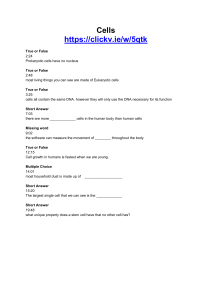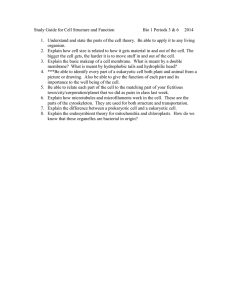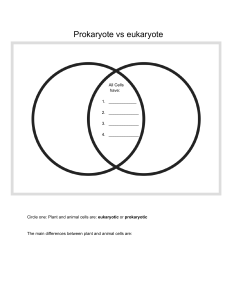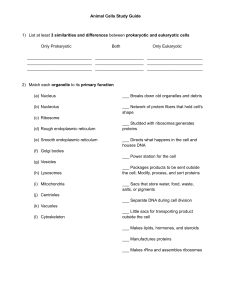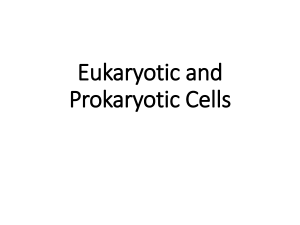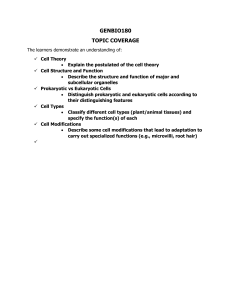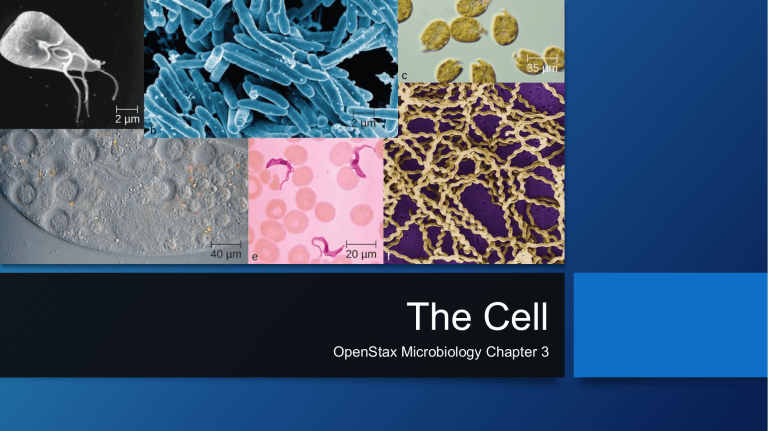
The Cell OpenStax Microbiology Chapter 3 Spontaneous Generation: Objectives Explain the theory of spontaneous generation and why people once accepted it as an explanation for the existence of certain types of organisms Explain how certain individuals tried to prove or disprove spontaneous generation Spontaneous Generation • What is it? • Early experiments • • • • Van Helmont – Mice from rags Francesco Redi – meat jars Needham – boiled broth Spallanzani – boiled broth Disproving Spontaneous Generation • Swan-neck flask • Irrefutably disproved spontaneous generation • “Life only comes from life” • “life is a germ and a germ is life. Never will the doctrine of spontaneous generation recover from the mortal blow of this simple experiment.” Foundations of Modern Cell Theory: Objectives Explain Explain the key points of cell theory and the individual contributions of Hooke, Schleiden, Schwann, Remak, and Virchow Explain Explain the key points of endosymbiotic theory and cite the evidence that supports this concept Explain Explain the contributions of Semmelweis, Snow, Pasteur, Lister, and Koch to the development of germ theory Origins • Robert Hooke • Coined the term ‘cell’ • Matthias Schleiden • Plant cells • Crystallization • Theodor Schwann • Similarities between plant and animal cells • Virchow and Remak • All cells arise from cells Endosymbiotic theory • Discovery of mitochondrial and chloroplast DNA in the 1960s • Resurrection of endosymbiotic theory • Mitochondria and Chloroplasts • Arose from prokaryotic cells • Relationship with eukaryotic host The Germ Theory of Disease • Ignaz Semmelweis • Handwashing • John Snow • Epidemiology • Louis Pasteur • If microbes spoil food, they could cause infection • Robert Koch • Postulates • Joseph Lister • Carbolic acid Cell and Germ theory: A timeline Explain Unique Characteristics of Prokaryotic Cells: Objectives Explain the distingui9shing characteristics of prokaryotic cells Describe Describe common cell morphologies and cellular arrangements typical of prokaryotic cells and explain how cells maintain their morphology Describe Describe internal and external structures of prokaryotic cells in terms of their physical structure, chemical structure, and function Compare Compare the distinguishing characteristics of bacterial and archaeal cells The Typical Prokaryote • All cells contain • • • • Cytoplasm Ribosomes DNA Cell membrane Common Cell Morphologies • Streptococcus pyogenes • Strep throat • Bacillus cereus • Food borne • Vibrio cholera • Cholera • Haemophilus influenzae • Pneumoniae • Aquaspirillum serpens • Fresh Water • Borrelia burgdorferi • Lyme disease Common arrangements Tonicity Review • Osmosis and water movement • Microbiological media • Isotonic • Hypertonic • Hypotonic The Nucleoid • Contains DNA • DNA associated proteins • Nucleoid associated proteins • Assist in packaging of chromosome Bacterial Plasmids • Extrachromosomal • Advantageous traits This Photo by Unknown Author is licensed under CC BY-SA Ribosomes • Protein production • Found in cytoplasm • 70s (Svedberg unit) Inclusions • Store excess materials • Nutrients • Metachromatic granules • Store phosphate • Sulfur granules • Magnetosome • Align cells to magnetic field • Gas vacuoles • Alter buoyancy • Carboxysomes • RuBisCO and carbonic anhydrase Endospores • Survival and Protection • Unfavorable environmental conditions • Sporulation • Lets walk through the steps • Germination • Once living conditions improve • Clinically significant • Bacillus • Clostridium Plasma Membrane • Fluid mosaic model • Things move • Selective permeability • Things go in and out Diffusion • NO ATP • Passive process • High to Low Facilitated diffusion • NO ATP • Passive • Charged and Large Molecules Active Transport • ATP required • Active • Low to High The Cell Wall • Protection of cell • Peptidoglycan • Only in bacteria • Target of antibiotics • Gram stain Gram + vs Gram • Layers of peptidoglycan • Outer Membrane Acid-fast cell wall • Mycolic acid • Mycobacterium Glycocalyces and S-layers • Capsule • Organized layer • Polysaccharides or proteins • Slim layer • Less organized • Polysaccharides, glycoproteins, or glycolipids • S-Layer • Structural proteins and Glycoproteins • Outside the cell wall • THE cell wall for some Archea Fimbriae and Pili • Fimbriae • Short, bristle like proteins • Attachment • Pili • F plius • Transfer of DNA Flagella • Help cells move • Basal body • Motor • Embedded in plasma membrane • Hook • Connects basal body to filament Flagellar arrangements • Different bacteria have different patterns • • • • Vibrio cholerae Spirillum minor Pseudomonas aeruginosa Escherichia coli Run and Tumble • Movements depend on flagellar configuration • Move in response to various stimuli • Light (phototaxis) • Magnetic fields (magnetotaxis) • Chemicals (chemotaxis) • Runs • Counterclockwise rotation and streamlined • Tumbles • Clockwise rotation and splayed out Explain Unique Characteristics of Eukaryotic Cells: Objectives Explain the distinguishing characteristics of eukaryotic cells Describe Describe internal and external structures of eukaryotic cells in terms of their physical structure, chemical structure, and function Identify and describe Identify and describe structures and organelles unique to eukaryotic cells Compare and contrast Compare and contrast similar structures found in prokaryotic and eukaryotic cells Eukaryotic Structure Review • Lets review cell structure/function Eukaryotic cell shape • Chromulina alga • Trypanosoma • Vorticella • Paramecium • Plasmodium The Nucleus • Command center • Contains DNA • Nuclear envelope • Allows movement in and out • Nuclear lamina • Intermediate filaments Nucleolus • Site of rRNA synthesis • Ribosomes The Endomembrane System • Endoplasmic reticulum • Rough ER • Smooth ER • Golgi apparatus • Protein packaging • Protein modification • Lysosomes • Digestive enzymes Peroxisomes • Produce H2O2 • Lipid synthesis • Can specialize • Glyoxysomes • glycosomes The Cytoskeleton • Microfilaments • Two actin strands • Amoeboid movement • Stability in cytoplasm • Intermediate filaments • Cables within the cell • Maintain position of nucleus • Anchoring cells • Microtubules • Tubulin dimers • Girders within cytoskeleton • Movement Mitochondria • Cellular powerhouse Chloroplast • Site of photosynthesis The Plasma Membrane • Selectively permeable • Molecule types Membrane Transport • Endocytosis • Phagocytosis • Cell eating • Pinocytosis • Cell drinking • Receptor mediated endocytosis • Ligands and receptors Cell Wall and Extracellular Matrix • Cell wall • • • • • Fungi Algae Plants Protists Structural support • Maintains shape and stability Flagella and Cilia • Cellular movement • Flagella • 9+2 arraignment of microtubules • Dynein motor proteins • Cilia • • • • Unique to eukaryotes 9+2 arrangement Cover cell surface Feeding • Basal body
